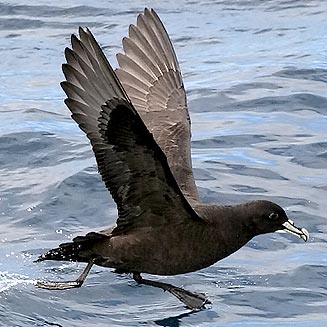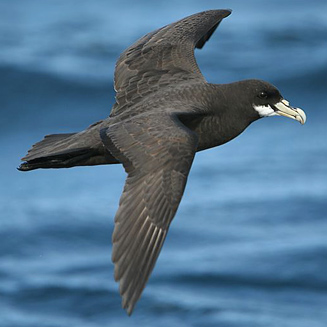|
Procellaria aequinoctialis
(White-chinned petrel)
Bassiaan [Afrikaans]; Witkinstormvogel [Dutch]; Puffin à
menton blanc [French]; Weißkinn-sturmvogel [German]; Painho-de-queixo-branco
[Portuguese]
Life
> Eukaryotes >
Opisthokonta
> Metazoa (animals) >
Bilateria >
Deuterostomia > Chordata >
Craniata > Vertebrata (vertebrates) > Gnathostomata (jawed
vertebrates) > Teleostomi (teleost fish) > Osteichthyes (bony fish) > Class:
Sarcopterygii (lobe-finned
fish) > Stegocephalia (terrestrial
vertebrates) > Tetrapoda
(four-legged vertebrates) > Reptiliomorpha > Amniota >
Reptilia (reptiles) >
Romeriida > Diapsida > Archosauromorpha > Archosauria >
Dinosauria
(dinosaurs) > Saurischia > Theropoda (bipedal predatory dinosaurs) >
Coelurosauria > Maniraptora > Aves
(birds) > Order: Ciconiiformes
> Family: Procellariidae
 |
 |
| White-chinned petrel. [photo
Jeff Poklen
©] |
White-chinned petrel, offshore from Cape Town, South Africa. [photo
Trevor Hardaker ©] |
Distribution and habitat
Breeds on sub-Antarctic islands, from the Falklands to
islands south-west of New Zealand, dispersing across southern oceans between
30-65° South (extending further north along the west coasts of South America and
Africa). It is common across southern African waters, while scarce to absent in
the north-west and north-east.
Predators and parasites
It has been recorded as prey of
Catharacta antarctica
(Subantarctic skua).
Movements and migrations
Present year-round of the south and west coast
of southern Africa, although especially common in winter, as most
birds return to their colonies in September.
Food
It mainly eats trawler offal and discards, supplemented
with crustaceans and squid, catching live prey by grabbing them from the water.
When foraging for scraps near fishing vessels it often settles with its head
beneath the surface, so that it can spot and pursue sinking offal and discards.
It also associates with tuna (Thunnus), Common dolphins (Delphinus
delphis), Dusky dolphins (Lagenorhynchus
obscurus) and Bryde's whales (Balaenoptera
edeni). The following food items have been recorded in its diet:
- fish
- Etrumeus teres (Red-eye)
- Maurolicus muelleri (Lightfish)
- Lampanyctodes hectoris (Lanternfish)
- Engraulis encrasicolus (Anchovy)
- Squilla armata (mantis shrimps)
- Sepia (cuttlefish)
- other crustaceans and squids
- trawler offal and discards
- Merluccius (hake)
- Coelorhynchus fasciatus (rattails)
Threats
Vulnerable, with a decreasing global population of
approximately three million pairs. Its South Georgia colony decreased in size by
28% over 17 years, mirroring similar decreases in other colonies. This situation
is thought to have been largely caused by longlines, which causes an estimated
45 000 mortalities every year. Thankfully this thought to be decreasing every
year thanks to changes in fishing practices.
References
-
Hockey PAR, Dean WRJ and Ryan PG 2005. Roberts
- Birds of southern Africa, VIIth ed. The Trustees of the John Voelcker
Bird Book Fund, Cape Town.
|
